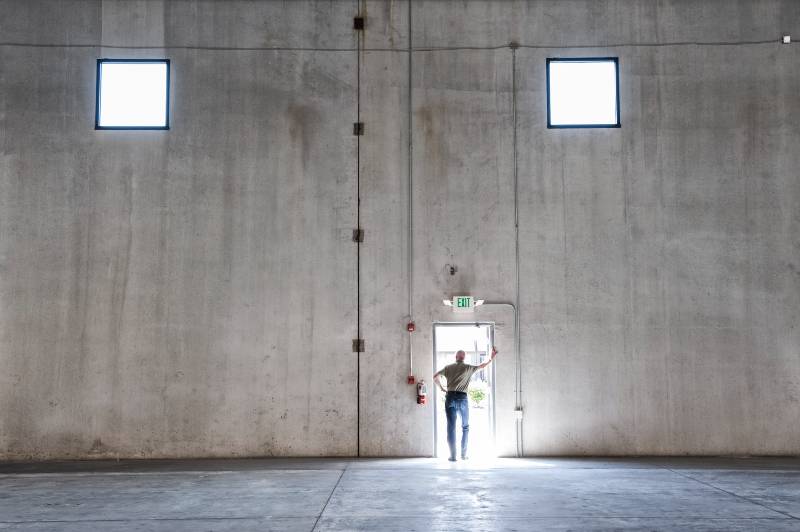The national warehouse vacancy rate has reached a historic low of 3.6%, according to recent statistics from CBRE, an American provider of commercial real estate services and investments. That means a lot of businesses are on to Warehouse relocation! In this blog post, we’ll discuss some of the most important things you need to know before moving your warehouse. By following our tips, you can minimize the stress associated with this process and ensure a smooth transition to your new location.
A warehouse relocation is a process that moves the entire contents of a building from one location to another. This includes all of the items in a warehouse, as well as any fixtures or equipment used to store and manage them.

What to Know Before You Move
Moving is a stressful process. We’ve all been there—you’re packing up your things, you’re concerned about how much of your stuff won’t fit in the new warehouse, and then you have to try to remember what you packed so you can unpack it all again.
But moving doesn’t have to be so hard. Here are some tips for making the move as painless as possible!
Here are some things you should know before moving:
What do you need?
Before deciding on which warehouse relocation service provider to use, you should know exactly what you need. Are you looking for long-term storage or just a temporary solution while you get set up in your new location? If long-term storage is needed, how long do you plan on storing items? Will they be shipped or picked up from the warehouse?
For example, it’s important to choose pallet racking systems that suit your needs and requirements. Pallet racking systems are often used in warehouses and storage facilities for additional storage space and for organizing materials in an orderly manner. They’ve been around for decades and are still popular today because they offer many benefits compared with other storage solutions such as shelving or specialized equipment.
Know your budget
Once you have identified what type of services you need, determine what kind of budget will work best for your business. You may want everything done within a certain period; however, this can greatly affect the cost depending on how much time it takes for everything to be completed and returned home. Also, take into account any extra fees that might be incurred due to weather conditions or other unforeseen circumstances that might delay the move at the last minute.
What to Pack
The most common mistake that people make when they move is packing too much stuff. This makes it difficult for them to move their belongings in one go and they end up having to make multiple trips back and forth which can be very exhausting.
Get organized
The key to a successful move is organization. This includes everything from planning and packing your belongings in an orderly fashion to keeping track of important documents and contact information for your service providers. A little bit of preparation can go a long way in making sure the process goes smoothly!
Questions to Ask Before Your Warehouse Move
Moving a business is never an easy task. This is especially true when it comes to warehouse relocation. A warehouse move can be challenging, especially if you don’t know what to expect. There are things that you need to consider before moving your warehouse to a new facility.
Here are four questions you must ask before your warehouse and equipment relocation:
How much space do I need?
It’s important to know how much space your business needs before you make the move. If you’re already in a warehouse, take the time to measure the size of the space where your business operates and how many employees work there. This will help you determine how much room you need when it comes time to find new headquarters.
Have I found the best location?
Planning for your warehouse relocation is finding the ideal location for your business. You need to find a place that has easy access to public transportation and major highways, as well as good visibility for customers and clients. The location should be large enough for all of your equipment and merchandise, but not too big that it will take too much time for employees to get from one end of the warehouse to another.
What will the cost be?
The cost of warehouse relocation is directly related to how far your goods will be moved and how many units need to make the journey. But there’s more to it than that. The type of product you’re moving and how much protection it needs will also influence the price. For example, if you’re moving high-value items such as electronics or machinery that need special handling, then expect to pay more for this additional care and attention.
What are my options?
Before choosing a warehouse relocation service provider, consider what other options are available. You may have heard of other companies who offer similar services, or there could be local movers who might be able to help out with your move. This way, you’ll get an idea of what services they offer, as well as their prices and quality of service before deciding which one to go with.
Things to Consider in Warehouse Relocation
Warehouse Downtime
The most important factor in moving your warehouse is downtime. You need to ensure that your warehouse will be operational as soon as possible after the relocation has been completed. If you have a lot of inventory, this may be difficult because it will take time for customers to get used to the new location and find their way there again.
To minimize downtime, make sure that all staff members know where everything is located and how to operate the equipment. It’s also a good idea to create an inventory spreadsheet so that everyone knows what they can expect when they arrive at work on Monday morning.
It’s also a good idea to assign someone who isn’t busy with other tasks to answer phone calls and emails during this period so that customers don’t have trouble placing orders or getting answers about products or services they need information about immediately.
Inventory Management
The most important thing to consider is inventory management. Before planning the move, you need to know how many items are present in your warehouse and where they are located. You also need to know how much space each item occupies. You should make sure that there is enough space to store them in the new location and that they do not get damaged during transport.
You need to plan out which items will be moved first and which ones will be moved last so that you can avoid any damage or loss of inventory during relocation. It may also help if you label each item with its location so that they can be put back in place after the move without any problem.
Location, Layout & Design of the New Warehouse
Warehouse relocation is a complicated process, and it requires careful planning to ensure that the relocation goes as smoothly as possible. There are numerous factors to consider, such as location, warehouse layout and design of the new warehouse, the type of equipment you need and the cost of moving everything.
Location is an important consideration when relocating your warehouse. You will want to find a suitable location that is close to your current site but still within budget and convenient for your customers. If you’re relocating interstate or overseas, then this may be more difficult than if you’re only warehouse moving down the street.
The layout and design of your new warehouse can make a big difference in productivity, efficiency, and safety. You should consider how much space each department needs for their operations, whether any environmental risks need addressing (such as noise) and what kind of lighting would work best for each area.
Costs Involved
The cost of moving can vary greatly depending on the distance and size of your warehouse space. However, no matter how much or little you’re moving, there are always going to be costs involved. Warehouse relocation is a complicated process, so You’ll need to hire professional warehouse relocation services such as movers, packers, and loaders who will cost you accordingly. You should also factor in the cost of renting trucks if necessary and any other equipment that may be required for the move.
Before You Move
Assess Current Design and Layout
Warehouse design and layout is a complex process, especially if you’re moving from one city to another or from one country to another. Your inventory, equipment, and employees will all play a part in determining where you should place everything during the move.
Your first step should be to assess the current design and layout of your warehouse. Are there any areas that could be better utilized? For example, if there’s an area that isn’t being used because it’s too far away from an entrance or exit, then it might make sense to change things up a bit at this point.
Create a Plan
This will help you stay organized and make sure that nothing gets overlooked during the process. You can use this plan as a guide and keep track of all the critical tasks that need to be completed before moving day arrives.
If possible, start thinking about your new location before anything else. Gather information about the area where you plan on opening up shop, including local amenities and attractions, nearby businesses, and other resources like banks and schools. The more prepared you are when it’s time to relocate, the easier the transition will be for everyone involved in your business.
Inventory
Before you start packing, make sure that you know what is in your warehouse. This means that you need to go through all of your warehouses and make an inventory of what is there. If it is possible, try to take pictures and videos of each item so that nothing gets lost or damaged in the process of moving.
Day of Move
Establish Roles for the Move
Before you start with the actual move, make sure that everyone who will be involved in this process has clearly defined roles and responsibilities. For instance, if you have employees who will be working on this project, assign them specific tasks such as packing/unpacking, loading/unloading, and supervising. This way, everyone knows what they need to do and there will be no confusion during the move.
Using Professional Movers
The day of the move should be planned carefully. You should make sure that all the employees have been informed about the move and their new workstations. You should also consider informing your vendors about the new location so that they can ship their goods to the new location. The best way to ensure that everything is in order is by scheduling a day of the move with professional movers in Melbourne who will take care of all your moving requirements. This will save you from last-minute hassles and help you avoid any unnecessary complications during the relocation process.
Preventing Damage and Theft
When you’re moving a company, time is money — so you want to make sure that everything goes smoothly on moving day. And if something does go wrong, you want to be able to deal with it quickly and effectively so that it doesn’t end up costing you even more time and money.
Here are some things to consider:
Make sure that all employees know about the move beforehand so they can prepare their light or even heavy equipment and pack up their belongings ahead of time. This will help them avoid having to rush around during the last-minute chaos of moving day.
If possible, move all warehouse equipment on wheeled carts or dollies so that they can be moved easily into the new space without damaging floors or walls (or yours). Don’t forget to check for any hazardous materials such as chemicals or paint thinner that could spill when handled roughly.

After You’re in Your New Space
Training, Warehouse Facility Walkthrough, and Other Final Tasks
Training
Whether it’s employees on the ground or those who will be doing the packing, the best way to ensure that everything goes smoothly is to give everyone a detailed overview of how the move will happen and what their roles will be. This includes an explanation of what needs to be packed, where items should go once they arrive at their destination, how shipping manifests should be filled out, and any other pertinent information.
Facility walkthrough
Once everyone has been trained on their responsibilities about the move, it’s time for them to get familiar with their new space. Employees should head over with their supervisors who can point out important locations like restrooms, break rooms, storage areas, and parking areas (if there are any). After this initial walkthrough is complete, employees should make sure that they know where everything is located so that they can find it easily when they need it.
Other final tasks
In addition to training and walkthroughs, there are a few other final tasks that need to be completed before the move is officially over. This includes things like updating employee contact information (so that everyone can be reached at their new location), setting up any new furniture
Warehouse Relocation FAQs
There are a few things that need to be considered when moving from one warehouse to another. This includes making sure that all employees are informed about the move, scheduling a day of the move with professional movers, and preventing damage and theft.
How do you prepare for a warehouse move?
The best way to prepare for a warehouse move is by ensuring that all employees are aware of the move and their new workstations. You should also inform your vendors about the new location so they can ship their goods to the new location. The best way to ensure that everything is in order is by scheduling a day of the move with professional movers in Melbourne who will take care of all your moving requirements. This will save you from last-minute hassles and help you avoid any unnecessary complications during the relocation process.
How do you prevent damage when moving a warehouse?
If possible, move all equipment on wheeled carts or dollies so that they can be moved easily into the new space without damaging floors or walls. Don’t forget to check for any hazardous materials such as chemicals or paint thinner that could spill when handled roughly.
Conclusion
Moving a warehouse is a daunting task. It can be difficult to know where to start, but by following the tips in this blog post and scheduling a free consultation with me, you can make sure your move goes as smoothly as possible. I’m here to help so don’t hesitate to get in touch!
Blog Articles Disclaimer
The information presented in articles on our website or affiliated platforms is exclusively intended for informational purposes. It’s crucial to grasp that this content does not constitute professional advice or services. We strongly recommend our readers to seek guidance from appropriately qualified experts, including, but not limited to, real estate and other attorneys, accountants, financial planners, bankers, mortgage professionals, architects, government officials, engineers, and related professionals. These experts can offer personalized counsel tailored to the specific nuances of your individual circumstances. Relying on the content without consulting the relevant experts may hinder informed decision-making. Consequently, neither Tolj Commercial Real Estate nor its agents assume any responsibility for potential consequences that may arise from such action.






